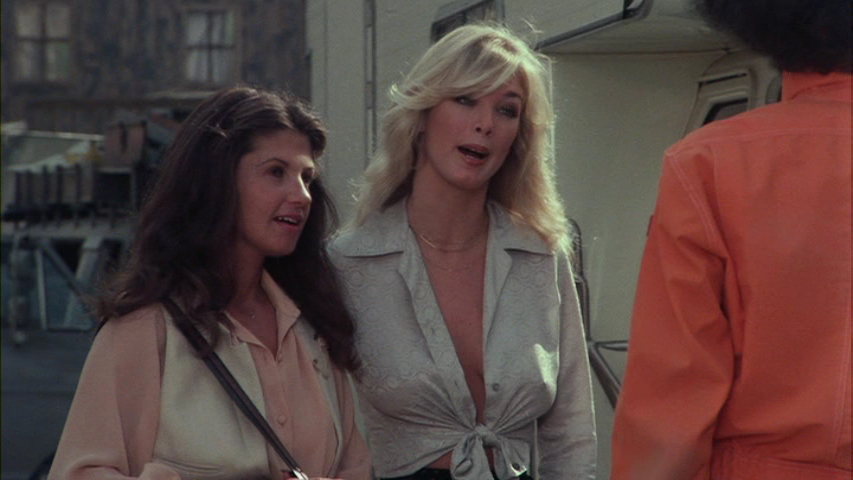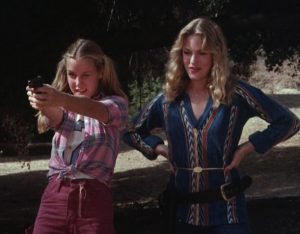Satan's Cheerleaders (1977) by #GreydonClark#JohnIreland #YvonneDeCarlo
A squad of #cheerleaders are kidnapped by #satanists looking for a virgin to sacrifice.
"When these girls raise hell… there's the devil to pay!"#NotQuiteClassicCinema pic.twitter.com/bUgdhcXSgH
— Angus Kohm (@AngusKohm) March 13, 2021
Greydon Clark is a name that I used to see on the backs of movie boxes in the 1980s, and in the credits of movies on late night TV. Unlike other names I recognized, like David Cronenberg or George A. Romero, I didn’t know anything about Greydon Clark – and watching a movie like Angels’ Brigade (1979) on TV certainly didn’t convince me that Clark was a great filmmaker. But somehow, over time, his name became a kind of second-string stamp of approval. It convinced me, on many occasions, that the odd looking film in my hand was worth renting – or buying.
Greydon Clark made about 20 movies between 1971 and 1998 – and I have several in my collection: Black Shampoo (1976), Hi-Riders (1978), Angels’ Brigade, Without Warning (1980), Joysticks (1983) and now Satan’s Cheerleaders (1977).
I wasn’t too sure if I had seen Satan’s Cheerleaders before, and watching it last week I’m still not 100% sure. I recognized the opening sequence (perhaps the first ten minutes or so), but the rest of the movie seemed completely new to me. I suspect that I started watching it on TV at some point and, for whatever strange reason, I stopped. I can’t imagine that I would have given up because I didn’t like it. For starters, it’s fairly bad right off the bat – but I mean “bad” in the kind of way that my friends I would seek out; a campy comedy about cheerleaders having fun at the beach – what could be better than that?
Secondly, I’ve always been a stickler for finishing movies. I had a theatre professor at university who advised us that we should never walk out of a play because “you can always learn something from it.” His advice made sense to me, and I realized that I had already been practicing what he was preaching in the way that I watched films. I wouldn’t have articulated it in the same way, but I don’t think I ever stopped watching a movie on purpose. If you had asked me why, I probably would have said “because you never know if it might get better.”
If I had to guess, I would say that I probably saw the beginning of Satan’s Cheerleaders really late at night and I just couldn’t stay up to finish it. Maybe I had a class first thing in the morning. Maybe I didn’t think I could fully appreciate it when I was already dead tired. Maybe I figured I would track it down and watch it properly at some point in the future. Whatever the case, I stopped watching the film and never got back to it.
Satan’s Cheerleaders has one of those titles that you never forget – and it’s certainly been on my must watch list for a long, long time. I think that the main reason I didn’t get to it before now is that I somehow convinced myself that I had already seen it. I may have been mixing it up with memories of Satan’s School for Girls (1973), a pretty entertaining made for TV movie with two of my favourite Charlie’s Angels (Kate Jackson and Cheryl Ladd) – but that’s another story.
Satan’s Cheerleaders is a weird cross between a cheerleader movie (a kind of sexploitation comedy, I suppose) and a Satanic horror film. It’s a fairly gentle, and almost tasteful (if you can use a word like tasteful to describe a movie about cheerleaders and Satan), example of those genres. It’s sexy in a silly way, and does have a few brief glimpses of nudity, but for the most part it’s about cheerleaders (and their teacher) in bathing suits, underwear, and skimpy outfits. As far as the Satanic “horror” goes, it’s pretty campy and low key. As I said to someone on Twitter: there may have been better cheerleader movies, there may have been better Satanic horror films – but there has rarely been a film that combined BOTH of those things.
Honestly, I can’t think of a single other cheerleader exploitation comedy/Satanic horror film. I may be forgetting something, but I’m going to suggest that Satan’s Cheerleaders is a fairly one of a kind film. This doesn’t exactly make it a cinematic triumph, but it certainly makes it interesting.
When I wrote about Greydon Clark’s Angels’ Brigade I noted the fact that he’d assembled a really amazing cast of old TV/film stars. He did the same thing for Satan’s Cheerleaders. John Ireland (Red River (1948), Gunfight at the O.K. Corral (1957)) plays a small town Sheriff who may be more sympathetic to Satan than cheerleaders in distress. His wife is played by Canadian actress Yvonne De Carlo, who is perhaps best remembered for playing Lily Munster on The Munsters (1964-66). Genre royalty John Carradine plays a bum who tries to warn the cheerleaders. Sydney Chaplin (Charlie’s son) plays a monk (of Satan). And Jack Kruschen, a character actor who I’m sure we’ve all seen appearing on numerous TV shows (some of my favourites include Barney Miller (1973-82), WKRP in Cincinnati (1978-82), The A-Team (1983-87), Remington Steele (1982-87) – the list goes on and on). He was also in movies like The Apartment (1960) and The War of the Worlds (1953). He has a face that is instantly recognizable to anyone who watched TV in the 1960s, ’70s and ’80s. I could not have told you his name, but I knew him as soon as he appeared onscreen in Satan’s Cheerleaders. – as Billy the school Janitor, who procures victims for the local Satanic cult to sacrifice. My mind was completely blown, however, when I looked him up on the IMDb and discovered that Jack Kruschen was born in Winnipeg, my home town.
Jack Kruschen and his family apparently moved to New York when he was still a young child, and then to Los Angeles where he was discovered performing in an operetta at Hollywood High School.
Canadians are bad at celebrating our own success stories, and Winnipeggers can be even worse. Sure we hear about Monty Hall, Deanna Durbin, and David Steinberg. But over the years, I have learned about many born in Winnipeg people who went on to great success in Hollywood and elsewhere – who never get mentioned as former Winnipeggers. Gisele MacKenzie, Marjorie White, Ted Rusoff, Joanna Gleason… Jack Kruschen is just the latest (and possibly greatest) example, and knowing who he is will forever change the way I react when I watch one of the over 220 TV shows and movies in which he appeared.
Satan’s Cheerleaders (1977) is classic Greydon Clark – which means it’s 100% Certified #NotQuiteClassicCinema. People with low or no tolerance for “bad” movies will probably want to give it a wide berth. People who are looking for seriously scary Satanic horror will not find what they are looking for here. But those who appreciate the finer things in life, like Ed Wood, Al Adamson, and that low rent sex comedy you saw back in junior high school but can’t remember the name of, will find Satan’s Cheerleaders to be a welcome ray of sunshine on a rainy #FridayNightAtTheHomeDriveIn.




